Background
Although the concept of the smart phone pretends to be cutting-edge, it was
really created by Nokia back in the early nineties with the 9000 series. It was
dubbed the Communicator and by combining telephony, e-mail, internet and PDA
functions in one item it lived up to its name. Despite the miraculous
convergence, however, it was not without its flaws. For a start, mobile data was
only available in GSM flavour and its paltry 9,600kbit/sec rate meant an
eternity waiting for anything internet-related. Secondly, it was enormous. I
mean really enormous; 9000 owners didn’t need to fear being mugged since they
could beat off any assailants with their phone.
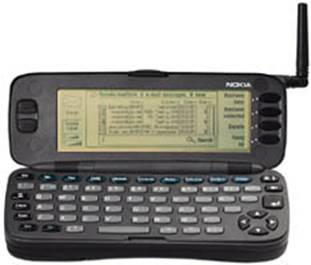
As a
result, the 9000 largely passed by un-noticed whilst the PDA world
rhapsodised about
Psion and Windows CE. Nokia, however was not discouraged and its engineers used
the long, Scandinavian winters to do something productive. Involving phones.
Next in the 9*** series was the 9110 which was smaller, lighter and sleeker.
Then, there was the 9210 which had essentially the same body as the 9110 but
with a
colour internal
screen, HSCSD (High Speed Circuit Switched Data) and the Symbian Series 80 OS.
The 9210i was exactly the same but with more memory, an Opera browser and a
silver (rather than black) keypad on the front. The last point was obviously the
deciding factor when I made up my mind to buy one.
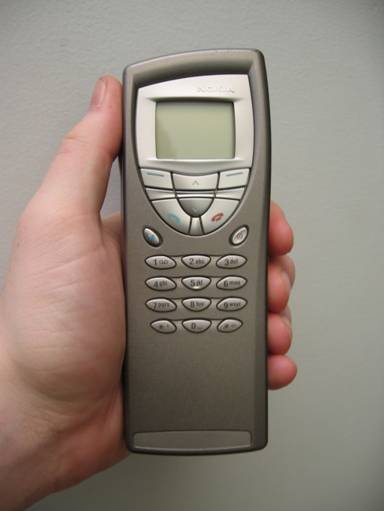
I
had my 9210i for several years and I loved it even though on almost every
logical count it was rubbish. Firstly, HSCSD was only ever supported by one
network in the UK (which I wasn’t with) and since the 9210i didn’t have GPRS, I
was stuck with the asthmatic snail that was GSM. Other problems included a case
that creaked when you looked at it, a lack of Bluetooth and touch screen, a mail
client that didn’t work with my account and, to cap it all off, a PC suite that
refused to work with Windows XP. Despite this, the phone had two saving graces:
a sensible keyboard and a 640×240 screen that made web-pages look acceptable. As
a result, it became my own little stand-alone PDA which ran my life for me.
After that little potted history, I can finally get to the actual subject of
this review: the 9500. Nokia obviously saw the 9210i as being slightly light on
features and, as a result has stuffed the 9500 with everything they could lay
their hands on. It has WiFi, Bluetooth, GPRS, EGDE, a camera, an MP3 player,
Real player and tri-band capabilities. As a result this probably won’t be the
most comprehensive review in the world but it should give a reasonable overview
of the phone.
The Phone
Hardware
Specifications
CPU:
TI OMAP 1510 RISC @ 150MHz
Memory: 80 MB Flash
OS: Symbian OS7.0s with J2ME
Battery: 1300mAh
Weight: 222g
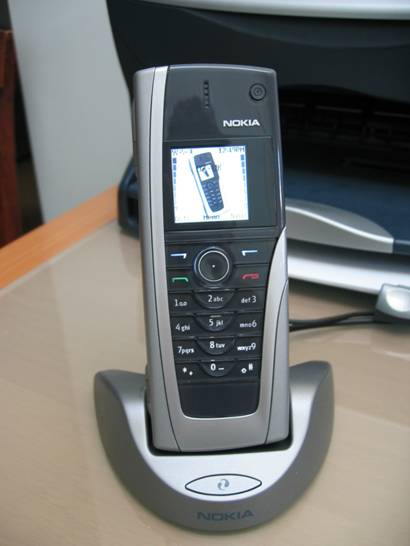
First impressions first and, after being used to the 9210, the 9500 looks like a
far more polished product its predecessor. It feels wonderfully solid and
creak-less and due to its slightly curvy and rounded styling the phone looks and
feels smaller than its predecessor even though there isn’t actually that much
difference.
One
notable change is that the front screen is now colour and uses Nokia’s Series
40 system giving it a bit more functionality than the old model. The keypad on
the front is slick and shiny with good "tactile feedback" but because Nokia
seems incapable of putting a normal keypad design on any of their new phones the
9500’s feels a bit clumsy. It does, however, offer changeable covers and keypads
(odd considering that its supposed to be a business phone) and at the moment
there are two options: black and white. Imaginative… One annoying thing about
the covers is that it’s very easy for dust to get between the cover and the
screen. For some reason, the screens on the front of Nokia phones appear to
accentuate any dust or scratches which for someone like me who dotes on their
new toy becomes very irritating. Compressed air sprays for camera seem to do a
fairly good job of getting rid of it but I’ve resolved not to take the cover off
unless absolutely necessary.
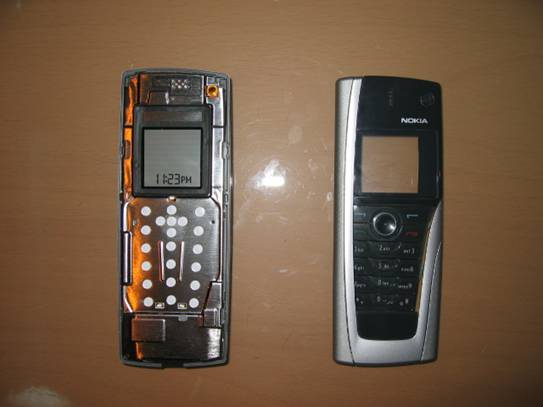
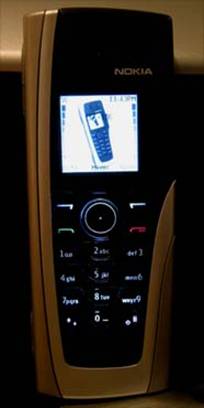
Some
other reviewers have complained about the absence of T9 on the front keys. I,
however, have never had much time for text entered through a numeric keypad,
predictive or otherwise, and since there’s a proper keyboard inside the phone
the lack of T9 doesn’t bother me in the slightest. The last change over the 9***
series that Nokia has made to the front of 9500 is one that new Communicator
users won’t notice: the position of the speaker. Whenever a 9*** series phone
appeared in a film, those in the know would have a little chuckle whenever the
person on screen using it held it to their ear with the keypad facing inwards.
This was because the speaker and microphone were on the back of the phone which
meant it had to be flipped round when making a call. With the 9500 they’re back
in the right place which is fine for new users but a pain for existing users;
I’ve answered several calls and wondered why the sound was so faint… The back
of the phone now sports the camera, two rubber grip strips and a panel that
covers the battery, SIM card slot and the MMC slot (which unfortunately doesn’t
support SD). Despite looking tidier than the back of the 9210, the battery cover
is a bit of a fiddle to remove when you want to get to the memory card.
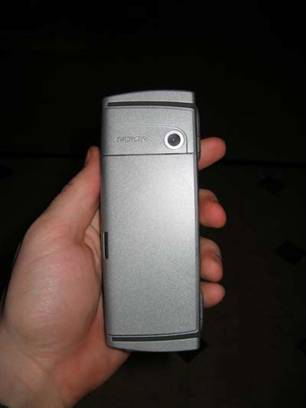
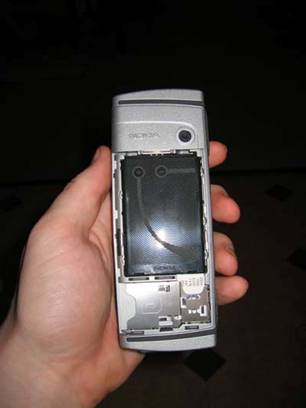
Like
most phone cameras, the one on the 9500 can only get to VGA resolution and as a
result the photos are fine for sending to other phones but not exactly something
that you’d want to print off. In bright light, though, the quality isn’t too
bad:

Quite frankly, the front interface on the 9500 is only for showing you the
numbers you’ve just pressed when entering a number and as a result I won’t spend
much time on it. The only other thing of note is that it runs Nokia’s Series 40
interface so should be familiar to anyone who’s used some of Nokia’s
non-smart-phones recently. On to the inside – the more interesting bit. Upon
opening the 9500, one is greeted by what looks pretty much like a laptop that
has been tortured on a rack and stretched a bit.
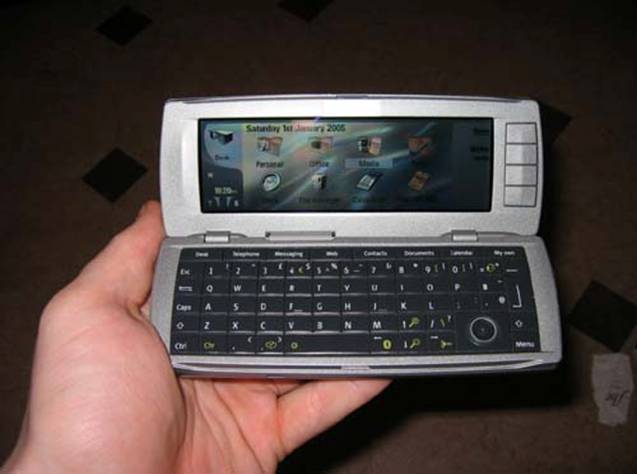
With
a 640×200 screen and full qwerty keyboard the 9500 feels far more like the
Psions and HPs of old than the PDAs of today and to a certain extent this
reveals the thinking behind the 9500. Whilst a Pocket PC or a Palm is more of an
extension of a desktop or laptop, the 9500 can genuinely be used as a standalone
machine. I know you can get fold away keyboards for other PDAs but they tend to
be the same size as the PDA itself when collapsed and however pain-free setting
them up is, it can’t compare to the ease of simply opening the communicator. The
keyboard on the 9210 was of the chicklet variety but on the 9500 its become more
like the Psion Revo with the keys laid edge to edge but without much travel.
Whether you like it really depends on whether your fingers are elfin or shaped
like sausages but I find it quite acceptable and have used it to type most of
this review. One thing that may put people off the 9500 is the lack of touch
screen but it shouldn’t since the Symbian OS has been set up very well for
keyboard control. The keyboard has a nine way rocker switch as well as four
cursor keys. When using the web browser, the pad controls a small on-screen
cursor and the four cursor keys act like a mouse scroll wheel which allows a
fairly pain free browsing experience. The lack of touch screen has also resulted
in a profusion of shortcut keys which can be seen on the top row of the
keyboard. These consist of Desk, Telephone, Messaging, Web, Contacts, Documents,
Calendar and the user assignable “My Own” key. Finally, there are the four
buttons that run up the right hand side of the screen whose functions are
indicated by on screen tabs next to them.
Although the design is a definite
improvement over the 9210, the 9500 is still slightly clunky. Although not quite
as deserving of the “brick” moniker that it’s predecessor had, it is still not
quite as svelte as the other devices that offer similar services such as the XDA
IIs, the Treo 650 and the P910i. Although I don’t have one handy for comparison
in the following photos, the Treo is about the size of the P910i when it’s
closed.
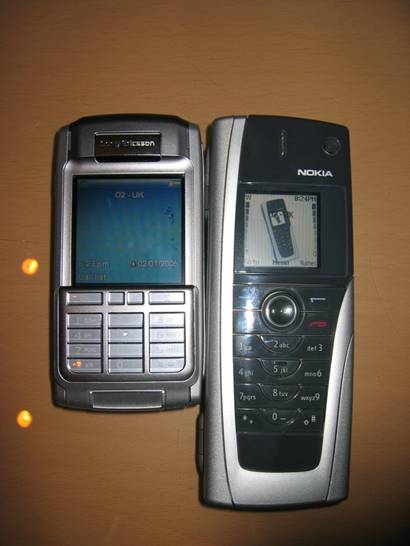
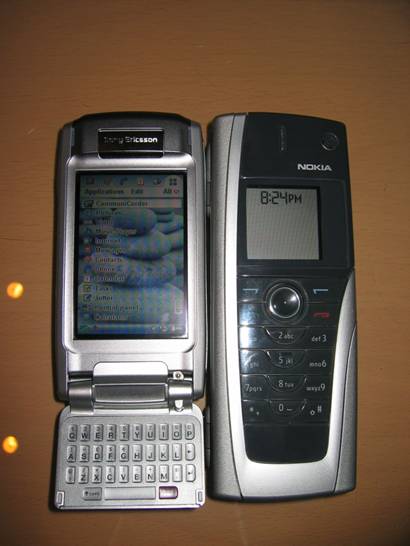
The internal screen is, without a shadow
of a doubt, the best screen I have seen on a PDA and is much, much better than
the screen on it’s closest competitors; the SonyEricsson P910i and the XDA IIs.
It’s also a match for, if not better than, the 1920×1200 screen on my laptop…
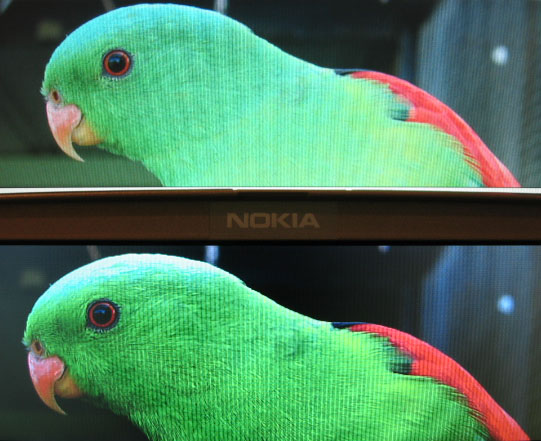
You can also set whatever picture you
like as your background on both the front and inner screens of the phone
although there’s no way of skinning either interface.
Applications
On the inside the 9500 runs the Symbian
OS7 with Nokia’s Series 80 overlay and as you’d expect, it has all the requisite
applications already installed. These include the Opera browser, a messaging
system that brings SMS, MMS, e-mails and received files in one place, a full
suite of office applications, a calendar, contacts etc. The menu system has been
simplified considerably over the 9210 and all the various programs and settings
can be access through Desk with the four basic shortcuts Personal, Office, Media
and Tools all of which are fairly self-explanatory. You can also place your own
shortcuts to programs and documents on the desktop. Personal brings together
your PIM programs, Office does the same with the “productivity” applications,
Media combines audio-visual things like Imaging and MP3 and Tools is mostly for
phone settings.

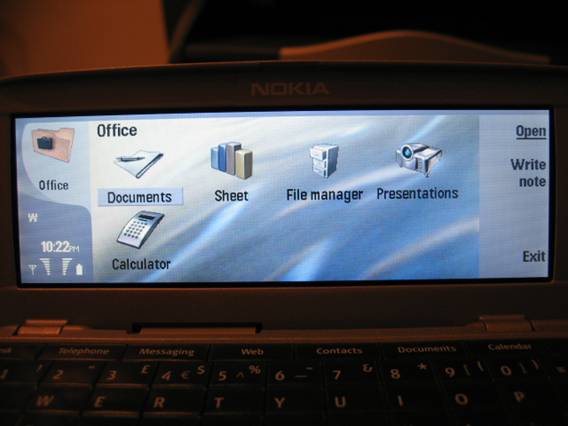
All the applications are fairly
straightforward and none of them really suffer from being on a device without a
touch screen (except the calculator; learn those keyboard shortcuts!).
Messaging, Calendar and Contacts all follow the same basic lay-out with the
entries being on the left hand side of the screen and their details on the
right:
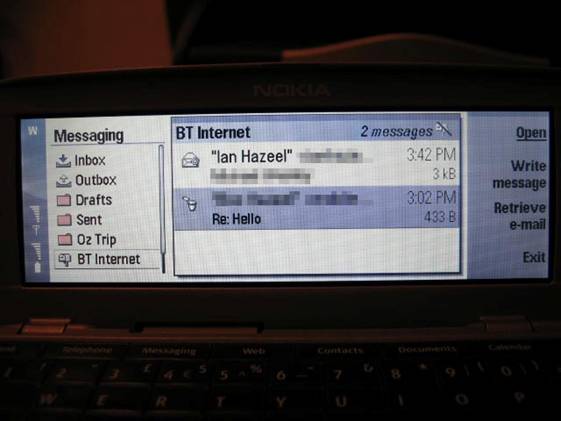
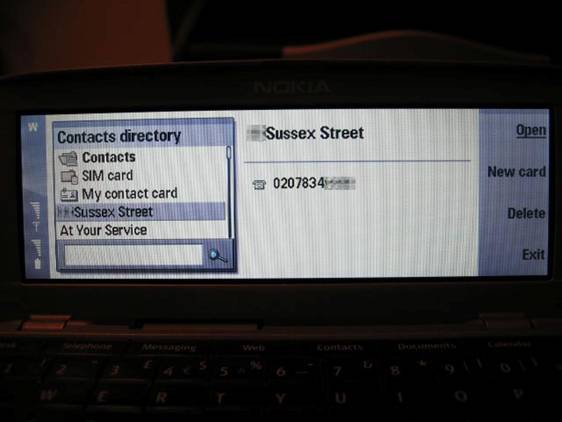

The only real disappointment for me, at
least, is that after coming from the 9210i’s word processor with its
spellchecking and superb thesaurus (better then Word XP), the 9500 has neither.
Although I’ll survive without them, it does seem strange that they’ve been left
out since the 9500 has more than enough memory for them…
Two other applications that deserve a
special mention are the MP3 player and Real Player. The former of these is very
good and although the 9500 doesn’t have a headphone jack, Nokia supplies
headphones that connect to its “Pop-Port” and, surprisingly for such a product,
they actually sound pretty good. The only downside is that they’re white and
have a little Nokia logo on the ear buds so when walking down the street you
might as well carry a sign saying “I’ve got an expensive phone, I have.”
Hopefully, with the rise of MP3 playing smart phones, it should only be a matter
of time until someone releases a pop-port to 3.5mm adapter. Because the 9500
doesn’t really have enough space for many MP3s, a memory card is pre-requisite
if you plan to be doing a lot of listening and a 1GB MMC card now goes for
around $100/£60.
As for Real Player, all I can say is
that Real Networks have successfully managed to condense all of the
user-unfriendliness and idiocy of their desktop version into a nasty little pill
for the 9500. The thought of being able to watch, say, BBC News over a wireless
LAN is very appealing and Real have obviously realised this and made sure that
it’s impossible. Which is a shame since it would have been a very interesting
illustration of mobile technology. Oh well…
Connectivity
The communicator’s claim to fame has
always been its connectivity and the 9500 doesn’t disappoint. On the cellular
side of things it offers HSCDS, GPRS and EGPRS (EDGE) which gives you
theoretical top speeds of just over 200kbps. Some may point out the lack of
proper 3G data facilities as a rather serious omission but in the UK, at least,
3G services have not yet reached the coverage (and cost) at which I would
seriously consider using them. By they time they do, I wouldn’t be surprised if
a new communicator model had come out to take advantage of them. The
configuration of the data facilities is very simple and the phone takes all the
settings from the SIM card and then creates the separate connections for GRPS,
WAP and MMS.
On the non-cellular side of things, the
9500 has Bluetooth and WiFi. The Bluetooth can be switched on or off using a
keyboard short cut but the default state is controlled through the settings
menu. When activated, a little Bluetooth rune appears on the left of the screen.
The WiFi can be set to search for wireless networks at regular intervals and
although it doesn’t announce it when it finds one, a small “W” appears in the
same place as the Bluetooth blob (see pictures above). There’s also an option to
automatically deactivate Bluetooth when using the WiFi since both operate on the
same frequency and although they can be used simultaneously, it increases the
likelihood of problems.
The 9500 comes with Nokia’s PC Suite
which allows you to synchronise your phone with Outlook (or Lotus Notes) via
either cradle and cable (see first picture of the 9500), infrared or Bluetooth.
All three seem to work well although the transfer speed for large files such as
MP3 is not exactly rapid and, on my computer, if the Bluetooth card has been
deactivated it takes a few minutes for PS Suite to realise that the 9500 is
nearby before syncing. The PC Suite also includes a number of other programs
such as a SMS sender and contact editor but to be honest, most of these are
intended for Nokia’s other phones and are superfluous since almost everything
can be either done in Outlook on or the phone itself.
The 9500 uses Opera as its internet
browser and the “Fit to page” function coupled with the 640 pixel wide screen
make internet browsing about as pain free as is possible on a palmtop (I know
that some of the newer PocketPCs have VGA screens but the text on them is
microscopic). When you open the web browser you’re greeted with the Nokia logo
and a link to the mobile version of Nokia’s website.

When you enter the address of a website,
the 9500 then offers you a list of available connections. Since it automatically
picks up the settings off the SIM card, O2 Internet is one of the options (for
me) but it also shows connections created manually and, if there’s one in range,
a wireless network access point. If there’s one of the latter about then is
comes under the “EasyWLAN” option which, when selected, allows you to select the
nearby network to connect to. If the network is an open one, you can just start
surfing but if it’s an encrypted one then you have to enter the network key.
Since doing this every time is a pain there’s an option in the settings menu to
create a permanent access point for any network that you use regularly.
Once connected, everything is fairly
straightforward and when using GPRS the connection feels about as fast as a
normal dial-up one but, if your network supports it, the 9500 can take advantage
of EDGE and shoot up to 200kbps. The WiFi connections I’ve tried it with (mostly
at airports) all seem to work well but there are two slight catches: firstly,
the phone only has a 150mhz processor and as a result the WiFi isn’t as fast as
it would be on a laptop. Secondly, although the phone is good at detecting
networks with weak signals, using them to browse the web can be a bit tiring as
the phone takes a bit of time to reacquire the signal when it loses it.
The e-mail accounts in the messaging
suite can also be configured to use the available connections and, as with the
web browser, usually work smoothly. Having a keyboard that is genuinely usable
along with almost every type of mobile connectivity makes the 9500 more of a
mobile e-mail device than anything else especially since RIM have announced that
they’ll be releasing a piece of software that gives it full Blackberry
functions. Since mobile data is very much on the rise (although I wish the price
could do the opposite) and European networks now have roaming for data calls in
addition to voice, it’s possible to keep in touch almost wherever you are,
regardless of country.
Conclusion
The 9500 is quite literally the phone
that can do everything but, as always seems to be the case, there is a
trade-off: the size. Although I’ve never found it to be much of a problem since
I usually wear a jacket or overcoat, the 9500 is the antithesis of the Motorola
V3 and is not a phone that will slip into a shirt or trouser pocket without
leaving a bulge. If is a bit smaller than its predecessor so compared to other
phones it’s not so much brick as briquette.
Would I recommend it? If I say that’s a
tricky question that doesn’t mean the phone is bad, it’s just that it has been
designed to very specific guidelines and as a result may not suit everyone.
Personally, I feel that the keyboard sets it apart from most of its other
competitors since none of them offer one that compares in usability. If,
however, you feel that a camera and wireless networking are not high on your
list of “must-haves” Nokia is just about to release the 9300 which has all the
features of the 9500 bar those two but at a smaller size. Although I don’t have
one to hand, it’s about half-way between the 9500 and the P910i size-wise.
Personally, I’m delighted with it and I
wouldn’t part with it. Although it may sound a little silly, you do feel that
mobile technology has started to make good on the industries’ promises when you
can sit at a restaurant at the top a mountain in the French Alps, take a picture
of Mont Blanc against a blue sky and then immediately e-mail it to your (soon
not to be) friends back in the office!

Addendum
Unfortunately, the phone I used for this
review is no longer with me. A few weeks ago the microphone had an appointment
with the Grim Reaper the company I bought the phone from agreed to a replacement
which should be in my hands soon. I haven’t heard anyone else having a similar
problem so hopefully it was a one off. One problem that does seem to be common
to all examples, though, is that the catch for the screen seems to get
progressively weaker after extended use. Although the catch was noticeably
looser on mine after I’d been using it for a bit, it hadn’t got to the point
where it became a problem. If anything happens with the new one I’ll keep you
posted.
Price: $799
Pros:
Display
Keyboard
Cons:
Bulky
Gerber Gear Suspension 12-in-1 EDC Multi-Plier Multitool with Pocket Knife, Needle Nose Pliers, Wire Cutters and More, Gifts for Men, Camping and Survival, Grey
23% OffGerber Gear Diesel Multitool Needle Nose Pliers Set, 12-in-1 EDC Multi-Tool Knife, Survival Gear and Equipment, Black
$129.99 (as of December 1, 2025 18:10 GMT -05:00 - More infoProduct prices and availability are accurate as of the date/time indicated and are subject to change. Any price and availability information displayed on [relevant Amazon Site(s), as applicable] at the time of purchase will apply to the purchase of this product.)Product Information
| Price: | 799.0 |
| Manufacturer: | Nokia |
| Pros: |
|
| Cons: |
|



Gadgeteer Comment Policy - Please read before commenting
Post your comments here in the Nokia 9500 Mobile Phone Review.
http://www.the-gadgeteer.com/nokia-9500-review.html
Just click the POST REPLY button on this page.
I’m sorry but it is well deserving of the “brick” label. It might look nicer than the 9210i, but considering the Treo 600/P910-size phones are already pushing it for size, so this thing must be gargantuan. It’s not a wonder that Nokia’s 90-series phones haven’t really caught on in a larger market. It’s almost the size of a sub-notebook. 😮
I think you’re missing the point sightly…
Firstly, it takes a rather large leap of imagination to say that the 9500 is the size of a sub-notebook since it’s comparable in weight and size to most PocketPC PDAs whilst having almost all the same features plus a phone and proper keyboard built in. The only other device I can think of with a very similar feature set is the forthcoming HTC design that T-Mobile has announced and that’s no twinkle-toes…
(Just to be a pedant, it’s the 7710 that runs Series 90. The 9500 runs Series 80.)
If the 9500 runs some other OS (e.g. Palm Os or PPC OS) rather than Symbian OS, then I think this will be really BIG not only in size but in sales. Symbian is big in Europe, but I think it has too many flavors (series 40, series 60, series 80, 90…etc) and the software written for one series doesn’t really work for other series and that is holding many back from buying it. The list of applications available is quite meager when compared to either Palm or PPC software list. I have had the chance to hold and tinker with one and believe me its not as big nor as heavy as you think and its as the reviewer said, very well put together.
You’e right about the Series 80 of course. But the forthcoming MDAIII/HTC is MUCH smaller than this clunker. I still wouldn’t try jamming it in my pocket of course.
I think your eyes must be configured slightly differently from mine if you’re saying that the MDA is much smaller:
http://x.msmobiles.com/portal/high-res-images/3gsm2005/mda-iv-compared-4.jpg
http://x.msmobiles.com/portal/high-res-images/3gsm2005/mda-iv-compared-7.jpg
It may be shorter but it’s much wider.
Well I haven’t seen one in the flesh so I didn’t know it was that big. It still looks a lot less awkward to hold up to your face like a phone though. Either way I prefer phones with PDA functions, not the other way around. The Treo 600 (which I have, and have also owned a 270 and P800) form factor would be perfect if it was a tiny bit thinner and the antenna was shorter/internal. I carry my phones in my pocket, and the Treo 600 fits but it’s still pushing it… just my personal preference I guess.
Well I find that the 9500 fits into my jacket pockets quite happily. The reason that I put up with its extra size, is that it’s pretty much replaced my laptop in most circumstances.
Interesting discussion about how many features one can jam into a relatively small device with an acceptable screen.
Anyway, I’ve recently purchased a beautiful device which is called ‘Qtek S100’ in Belgium, aka ‘HTC Magician’, ‘i-mate JAM’ and ‘MDA compact’ (how do they cope with all these names?!).
Okay, it doesn’t have WiFi (which I don’t use), but is really packed with interesting stuff, and, rather important to me, runs Windows Mobile 2003 Second Edition v.4.21. It’s got Bluetooth, SD-slot, 1.3megapix camera, IR, touchscreen in prtrait or landscape mode, etc, etc.
Review:
http://www.mobile-review.com/pda/review/htc-magician-live-en.shtml
No complaints yet! 🙂
The Jam/Magician/MDA Compact/XDAIII (phew!) is indeed very diddy but I have a couple of problems with it. Firstly, the screen is ccompletely exposed. I know you can get screen protectors but even with them on, I still wouldn’t feel happy putting it into a pocket with anything else in for fear of the screen being damaged.
Secondly, whilst PocketPC is very good for multimedia and variety of applications, after playing with the Jam’s big prother; the PDA2K, over a few days I found that using the phone, bluetooth and WLAN frequently seemes to be more than the thing can stand and I had to shove the stylus in it with alarming regularity…
Just a note, all those Series 40, 60 etc are GUI developed by Nokia. Series 40 runs on top of Nokia’s proprietary OS while Series 60 and the rest runs on top of Symbian OS.
During my brief period with Series 60 and UIQ, it seems there are alot of promises with the OS. I can’t wait till it develops properly. As smartphone OSes goes these are the best. I can’t handle WM for Smartphone and my JAM’s Pocket PC PE can’t handle one handed usage much.
My sentiments exactly :x. They manage this in all their versions, and thus had the privilege of being the first deleted from the ROM of my T3!
As I said in the review, the most annoying thing about Real Player is that you’d expect that it would be possible to watch streaming media over a WLAN connection (at least) and yet it refuses to comply. It also refuses to play .rm files for the PC! You do begin to wonder whether it was actually programmed by the same company…
A few other updates about the phone; my replacement phone arrived a while ago and so far it’s been working perfectly. Whilst the catch is definitely looser than it was when fresh out of the box, it doesn’t seem to be getting any worse *crosses fingers*.
I also got the new version of Nokia’s PC Suite and the bluetooth function is very much improved over the previous version and connects pretty much as soon as you bring your phone within range.
One last thing is the IP passthrough feature which (as advertised) allows you to access the internet connection of a connected computer via bluetooth, cable or ad-hoc wifi. Unfortunately, Nokia haven’t actually released the PC drivers for it yet….
I really like the 9500 but one of the thing that is keeping me from getting one as I’ve said is the meager software available compared with Palm and PPC. I am using a Hp hx4700 right now and have used the XDA for a short while, as good as the current PPC OS is, it’s still quite clunky and requires periodic soft resets to speed thing up once you start using it for a while. On the otherhand, I find Palm to be a real good OS for convergent device because of its simplicity/ straight forward efficiency as well as the huge amount of 3rd party software available. Its quite stable also (at least, in my own experience with the Treo 600) I am keeping an eye out for the Treo 650 – the memory issue just throws me, but if PalmOne manages to solve the memory issue of the Treo 650 then, the Treo will most definitely be one of the best convergence device out there. – the only black eye left is the lack of wifi.
[QUOTE=The Doctor]The Jam/Magician/MDA Compact/XDAIII (phew!) is indeed very diddy but I have a couple of problems with it. Firstly, the screen is ccompletely exposed.
> That’s correct, I’ve been very carefully putting it my jacket’s pocket since day one, as I’m not very keen on leather or alu cases, which only add weight and size.
I once owned a Treo 180g (the graffiti version), which was -upon purchase- the perfect device for me: I manage lots of appointments, 1.000 contacts, notes and tasks, I’m a pure PIM-user and carry a pda and phone 5 days/week, 12hrs/day. Although the idea was a catch (acceptable size/weight, flip cover, vibrating alarm with an actual switch (!), reliable Palm OS, good mono screen, fair battery life,…) it appeared to be a total nightmare. It took me hundreds of hard resets and two replacements from the vendor before I gave up.
I switched to the XDA1 and was fairly happy, mostly because of the stability of WM. I’ve used it for 16 months and crashed it 6 weeks ago (unprotected screens…). I seriously considered the Treo 600 but the experience was just too bad, and I went to the Jam/Compact/QtekS100.
Apart from battery life, I find the screen to be acceptable, the size super, and using BT for the handsfree carkit + using the PIM at the same times works great. I might have actually found a good device… 😉
MattCatt (Cassioppeia E115 > Compaq iPAQ3630 > Palm Vx > Psion Revo > Treo 180g > XDAI > hp 1940 > QtekS100(XDA Compact)…
I just got the Treo 650- my complains are the lack of memory, the memory management scheme and no wifi – aside from that it’s as near to perfect as a convergent device can get.
My only gripe with the Treo is its thumb-board. Although I’m sure it’s usable, it isn’t a patch on the 9500’s 🙂
Im curious about the example photgraph. Gidleigh Park by chance?
Dear Colleagues,
I own a N9500 which I purchased here in the Philippines (Asia-Pacific). I use the WiFi / WLAN to connect to the internet and check my yahoo email (Free account, http://mail.yahoo.com). The browser is capable of loading the full web page. Once I have signed-in, I could read my messages and download messages with attachment/s and save them either on the Memory Card or Device Memory. I could also start composing messages. I am able to send message in plain text but I encountered problems when sending with attachment, say, a single jpeg file (less than 100kb).
Once I click on the ATTACH button, the browser opens another window wherein I could browse the file that I would like to attach. If I click on the BROWSE button, a Pop-Out Message appears that instructs me to browse for the file to be attached. Once a file is selected, it will be paste on the FIELD. The ATTACH button should be click if I wanted to confirm message with attachment or if not the CANCEL button. The ATTACH button doesn’t work and I cannot proceed attaching the file. In order to continue with the message, I have to click on the CANCEL button.
In short, the problem is that I can send messages only in plain text (this for yahoo account). It is much worst with my free hotmail account, I cannot compose messages.
Can anyone solve this problem.
Truly yours,
Ian
My only guess would be that the Yahoo attachement system isn’t compatible with the Symbian file system. I haven’t had any problems attaching files to messages sent using the “Messaging” program on the phone.
No, it’s my family’s house in West Sussex.
http://img.photobucket.com/albums/v395/thedoctor/house.jpg
Hi Doc,
I also tried connecting to my mail account via the MESSAGING Program. If you said you didn’t have problem, I do have a problem.
I used the SETTINGS WIZARD to configure my EMAIL: Country=Philippines, ISP=Yahoo Mail, Internet access point=Easy WLAN. Then I Press on the CONFIGURE (Command Key) to key-in my *User name & *Password.
Once I finished the set-up, I have added my Yahoo Mail Account on the MESSAGING Program. I checked the settings and the E-mail account type is POP3, Outgoing e-mail server is smtp.mail.yahoo.com, Incoming e-mail server is pop.mail.yahoo.com Use SMTP authentication is YES.
I cannot retrieve, send, and go online using this MESSAGING Program. There is a Pop-Out Message that it cannot proceed.
I’m afraid I’m not sure what else to suggest. The only other think I can think of is to delete the Yahoo account on your Communicator, restart it and reinstall the mail account.
Do you have any other accounts you can test it with?
Thanks for the great review.
I’m interested in purchasing the 9500 or the 9300 for use in the US. Silly question, can you enter a $ symbol? I checked the manual briefly but couldnt find.
Also, have you tried the Acrobat PDF viewer on this? How is it?
Thanks
Thanks for the compliment but I don’t think my prose is exactly great!
As for your questions, there is indeed (on the 9500, at least) a $ symbol on the “4” key along with a € symbol.
The Acrobat reader, for a mobile version actually works quite well. I’ve been using it mainly for reading books from Project Guttenberg and haven’t had any problems. Since you asked, though, I’ve tried it with more compicated file (a brochure) and although it takes longer to load, once it’s done so navigating round the document isn’t irritatingly slow.
Hope that helps!
Thanks for trying it out!
Nice review. I wanted to know as of now if you had any problem with that screen after sending it away “to camp” and I heard alot of people had bluetooth issues with it. Most from the US is that because there stupid and don’t read how to use bluetooth or walk too far from the phone as they talk. So far after reading so much stuff on this phone that’s the only 3 problems I heard. Bluetooth, Screen, and well emergency products at your local store.
Hi there ! i have a Nokia 9210i and a 9500… The 9500 inside screen is broken , do you think the one of the 9210 could fit and work in the 9500? thanks !